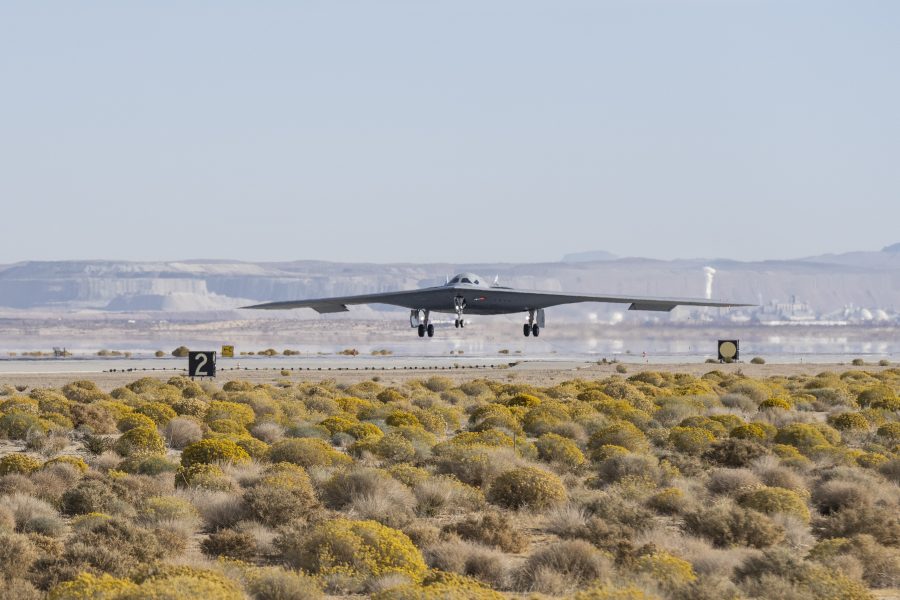NATIONAL HARBOR, Md.—The B-21 Raider bomber, which began flight testing last November, is now generating sorties as frequently as twice per week at Edwards Air Force Base, Calif., and ground testing of two similar aircraft is well underway, program officials said at AFA’s Air, Space & Cyber Conference.
“We’re really starting to strike up a flight cadence,” Northrop Grumman aeronautics president Tom Jones said in a panel discussion on the B-21.
Also during the panel, officials released the first official video of the B-21 flying, though amateur videographers have captured footage of the aircraft before.
“We’re actually able to generate two test flights, sometimes, in a given week, which, if you think about how far [in the flight test program] we are, that’s great,” Jones said. When the B-21 contract was awarded in 2015, “we made a vow that we were going to design this system to be a daily flyer.”
“Clearly,” Jones said, “I think we’re well on our way to delivering the kind of asset that can be that daily flyer” for Global Strike Command, something that has only rarely been achieved with the B-2, due to its need for heavy maintenance after every sortie.
The first B-21 to take to the skies is still the only one that has flown, however.
Jones said Northrop’s goal with T-1—the first flight test aircraft—was that it would be as near to the eventual production version, P-1, as possible. Flight tests so far have largely validated the digitally predicted performance.
“Everything we’ve heard is, it flies very much like the model,” Jones said. “We’ve been able to make significant expansions of the flight envelope to date, and we’re finding the model to be accurate enough that we’re actually using the model itself to inform our test points and our test plan, in which I think is very good place to be.”
“The handling qualities are better than expected coming out of the simulated environment—validating the accuracy of the digital models the team has developed and analyzed over many years,” Northrop test pilot Chris “Hoss” Moss, said in a release.
There are three aircraft in test, Jones said. Panelists did not disclose any planned flight test milestones or say when a second B-21 might take flight.
“We’ve got the one in flight test, and we’ve got two in structural tests,” Jones said. One is in a structural life test, wherein metal bars, pulleys, and wires pull and push on the airframe to find out where it might break after years of flying. The tests will determine how the B-21 ages over time. This is not “flashy,” Jones said, but “if you intend to build a lot of these and operate them for a long time, this is very important work. … All components that have to advance if you’re going to be successful.”
An Air Force spokesperson said the three B-21s referenced by Jones are included within the six B-21s the service has acknowledged are in some stage of construction.
“I’d say…I think the program is progressing very well,” Jones said. “I don’t want to jinx myself, but we’ve had more issues with test fixtures and training of our test personnel that we actually have of the test article itself, which, again, is a pretty good place to be at this point.”
Jones said the goal of making T-1 nearly the same as P-1 “saves a lot of…risk” on the program, chiefly because it will smooth and streamline the progression from flight test to production-level aircraft.
The B-21 has been designed with an open architecture to be able to adapt to changes in the threat, said William Bailey, director of the Air Force Rapid Capabilities Office, which manages the B-21.
“Hopefully people are tracking the fact that the threat environment is very complex, and it’s very dynamic,” Bailey said. “You know, our adversaries have been watching us for 30 years … and they are not stupid, and they are not static, and they are demonstrating that they can develop and field things that complicate our plans, and that’s why this pursuit of an open design is so important. You need to plan for this.”
The Air Force is “not stupid or static, either,” he added. “We watch them as well, and really at that point it allows us to not only take into account an environment where there’s going to be new threats, but it also enables the opportunities for new technologies, for new companies that did not exist when we first pursued these things.”


